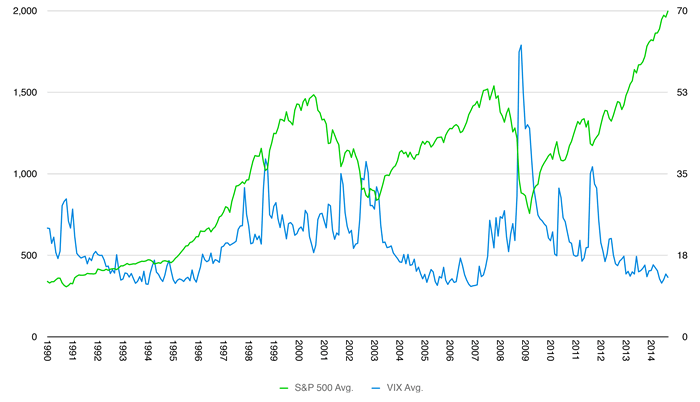VIX, the “Fear Gauge” Index
 The VIX (VIX), widely known as the “Fear Gauge” index, is a measurement of the implied 30-day volatility of the S&P 500. The higher the VIX, the more investors fear that a market decline is in the near future; conversely, the lower the VIX, the more complacent investors are about the market.
The VIX (VIX), widely known as the “Fear Gauge” index, is a measurement of the implied 30-day volatility of the S&P 500. The higher the VIX, the more investors fear that a market decline is in the near future; conversely, the lower the VIX, the more complacent investors are about the market.
This past summer, the VIX registered the lowest level seen in the last seven years, implying that investors are not fearful of a near-term market correction or a stock market crash. Despite the political conflicts in Russia and the Middle East, the VIX today is not far from that summer low, signaling that investors still do not expect a sharp stock market decline.
The VIX was developed in the early 1990s and has spiked above 40 in every market correction since that time. The VIX itself cannot be owned, but there are multiple ways to gain from spikes in the VIX. Several VIX-oriented investment products can be utilized as a hedge for your portfolio. Through our internal research, we have established a buy trigger and a sell trigger for these investments. Our internal buy trigger has worked in each 10+ percent market correction since the creation of the first VIX investment product in 2009. It is important to note that our buy trigger initiates after the market has lost some value, typically 4-6%. In recent market corrections, a position in a VIX-oriented product (under our guidelines) would have not only produced a profitable investment, but would have considerably protected a portfolio from market-driven losses.
If you have any questions regarding VIX investment products or would like to protect your portfolio using a VIX investment product, please contact your portfolio manager.
S&P 500 vs. VIX

Source: FactSet



